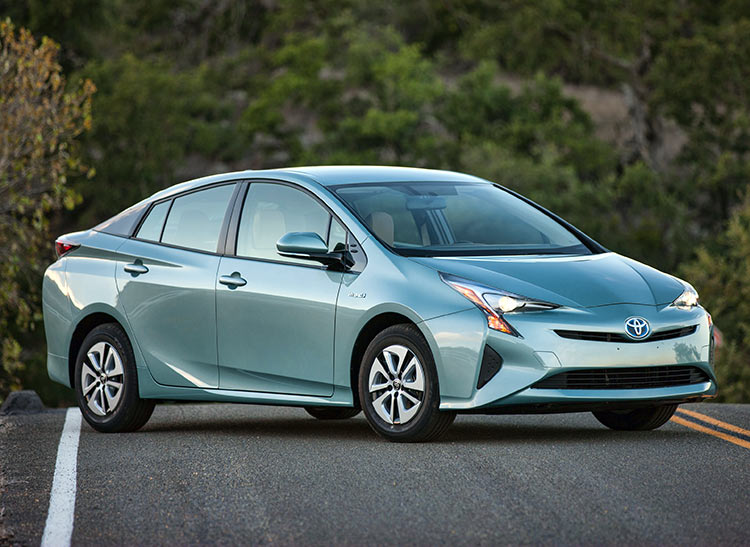Green car sales up in October: Hybrid and plug-in vehicle sales were up from a year ago  during October but down from September, which was the case with the overall new vehicle sales market. Sales were up for each category (hybrid, plug-in hybrid, and battery electric) year-to-date. Hybrids came in at 2.18% of U.S. new light duty vehicle sales in October, and plug-in electrified vehicles made up 0.996%. The Toyota Prius Liftback continues to fall out of place as the top selling hybrid in the U.S., coming in third place last month behind the Ford Fusion Hybrid and Toyota RAV4 Hybrid. It’s still the leading hybrid model for this year at 55,443 units sold versus 49,764 of the Ford Fusion Hybrid. The Prius Liftback is way down from last year, with 83,793 sold at this point in time during 2016. The Fusion Hybrid has almost doubled in volume form 26,699 sold through October 2016. The Chevy Bolt was the leader, by far, in plug-in electrified vehicle sales last month, with 20.7% of plug-in vehicle share. The Chevy brand took the first and third spots in total U.S. plug-in sales for the month. The Tesla Model S and Model X were way down in sales from September (75.6% and 73.5%, respectively), as the company struggles to prepare its car and battery factories for producing large volumes of the Tesla Model 3. For this calendar year, the Model S is No. 1 in U.S. plug-in sales, while the Model X is in the fifth position.
during October but down from September, which was the case with the overall new vehicle sales market. Sales were up for each category (hybrid, plug-in hybrid, and battery electric) year-to-date. Hybrids came in at 2.18% of U.S. new light duty vehicle sales in October, and plug-in electrified vehicles made up 0.996%. The Toyota Prius Liftback continues to fall out of place as the top selling hybrid in the U.S., coming in third place last month behind the Ford Fusion Hybrid and Toyota RAV4 Hybrid. It’s still the leading hybrid model for this year at 55,443 units sold versus 49,764 of the Ford Fusion Hybrid. The Prius Liftback is way down from last year, with 83,793 sold at this point in time during 2016. The Fusion Hybrid has almost doubled in volume form 26,699 sold through October 2016. The Chevy Bolt was the leader, by far, in plug-in electrified vehicle sales last month, with 20.7% of plug-in vehicle share. The Chevy brand took the first and third spots in total U.S. plug-in sales for the month. The Tesla Model S and Model X were way down in sales from September (75.6% and 73.5%, respectively), as the company struggles to prepare its car and battery factories for producing large volumes of the Tesla Model 3. For this calendar year, the Model S is No. 1 in U.S. plug-in sales, while the Model X is in the fifth position.
Case study on fleet savings: Tesloop, a two-year-old company based in Culver City, Calif., that takes passengers to and from locations in Southern California in a Tesla, has released a case study showing how much money fleet operators can save going with electric vehicles over traditional gasoline-engine luxury cars. Looking at total cost of ownership over 300,000 miles with a Tesla Model S compared to a Mercedes S-class and Lincoln Town Car found that, in the case study, Tesla Model S cost only $10,500 in maintenance and fuel costs. The Mercedes had about $86,000 ($52,000 for maintenance and $36,000 for fuel) for the same mileage. The Lincoln Town Car had about $70,000 ($28,000 for maintenance and $42,000 for fuel). It is only a case study with several variables changing based on several conditions, but the cost savings are being seen by fleets for electric passenger cars and commercial vehicles; that has much to do with a lot less maintenance and replacement parts needed for electric drivetrains along with substantial fuel savings.
Shell shifting away from motor fuel: One of the Big Oil giants, Royal Dutch Shell, is preparing to bring in more future revenue in other segments than vehicle fuel. As its executives have been stating  in the past year, the company expects that demand for gasoline will likely reach its peak by the 2030s with owners switching over to electric vehicles ad traditional engines becoming even more efficient. Refined oil products and petrochemicals present a viable market growth opportunity, the company says. Examples include viable substitutes for asphalt as developing nations build more roads; or for polymers and chemicals used in production of cars, toys, and clothes. Shell will be doubling the size of its chemical operations by the mid-2020s with several new plants coming to Louisiana and Pennsylvania that benefit from access to cheap shale gas. The oil company wants about 20% of its revenue from its worldwide fuel stations to come from electric vehicle charging stations and from low-carbon fuels by 2025.
in the past year, the company expects that demand for gasoline will likely reach its peak by the 2030s with owners switching over to electric vehicles ad traditional engines becoming even more efficient. Refined oil products and petrochemicals present a viable market growth opportunity, the company says. Examples include viable substitutes for asphalt as developing nations build more roads; or for polymers and chemicals used in production of cars, toys, and clothes. Shell will be doubling the size of its chemical operations by the mid-2020s with several new plants coming to Louisiana and Pennsylvania that benefit from access to cheap shale gas. The oil company wants about 20% of its revenue from its worldwide fuel stations to come from electric vehicle charging stations and from low-carbon fuels by 2025.



